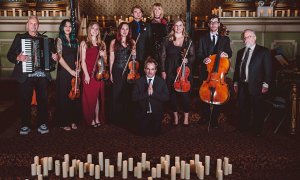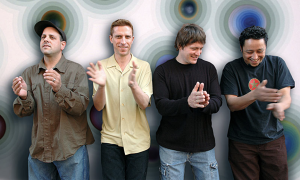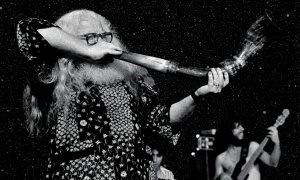Home » Jazz Articles » From the Inside Out » Five Classics Plus One
Five Classics Plus One
As a rule, Evans could pick up the program from an elementary school chorus festival and play it inventively and beautifully. This set is no exception.
 James Carter
James Carter
Live at Baker’s Keyboard Lounge
Warner Bros.
Just like he covers every saxophone, Carter covers just about every style, on Live at Baker’s. On the first track, Oscar Pettiford’s “Tricotism,” his playing reshapes a solid groove into an harmonic adventure much further out, like Lou Donaldson and Pharoah Sanders blowing on the same bandstand. On Don Byas’ stately tenor ballad, Carter swings “Free and Easy.”
Carter and guest tenor David Murray lay an ass-whipping on “Freedom Jazz Dance” of which its composer – the lamented, mercurial Eddie Harris – would surely be proud. Dueling on the melody, each inspiring the other to play hotter, while the drummer boils the pot with a hard-rocking snare sound, a true flash of transcendent musical communion from a blazing spirit of live performance. Just great.
Guest tenor Franz Jackson lays a hilarious vocal down in this charmingly unpolished “I Can’t Get Started,” as Carter’s soprano sings sweet and light in contrast to Jackson’s gruff “Satchmo” vocal.
The set ends with Carter, Murray, Jackson and Johnny Griffin ALL honking tenor madness on an electrifying eleven-minute workout through “Foot Pattin’” which showcases bassist Armstrong in a taffy-pull, elastic solo spot. In the true Motor-city tradition of bassist James Jamerson, Armstrong plays the musical fulcrum and unsung hero throughout, hot-wiring “Tricotism” and “Foot Pattin’” then driving them hard to their finish, and sliding deep down into the funk of “Freedom Jazz Dance.”
As for Carter, he looks back in his liner notes at this gig as “a hip and blessed homecoming.” Who says you can’t go home again?
 The Ornette Coleman Quartet
The Ornette Coleman Quartet
Ornette!
Atlantic Jazz Masters
Saxophonist Coleman recorded Ornette! about a month after his milestone Free Jazz sessions, retaining bassist Scott LaFaro, drummer Ed Blackwell, and the amazing Don Cherry on pocket trumpet. Four tracks, each titled with an acronym, from the original 1962 release are supplemented by a fifth, “Proof Readers,” for this reissue.
Ornette! uniquely blends musical tradition and revolution. Most arrangements sound almost conventional now, with melody statements leading into and out of each piece. Coleman honks out a surprising number of familiar-sounding R&B expressions, and Cherry burns through some Dizzy bop chops, in “W.R.U.”
How they employ them is, of course, an entirely different matter. “W.R.U.” also sounds extremely difficult for the rhythm section, particularly the bassist, to navigate, and “R.P.D.D.” sounds like it’s missing its pianist, though not from lack of LaFaro’s rhythmic and harmonic effort.
“C. & D.” scales the session’s peak: LaFaro tumbles through his walking basslines like a gymnast underneath Cherry as Blackwell impeccably rings out time on his cymbals, playing free but never feeling out of control – the freedom of discipline. Although sometimes viewed as musically dour, Coleman sounds positively joyous in its middle section, while Cherry also suggests Kenny Dorham and even the inscrutable Miles.
It is tribute to Coleman’s vision that, four decades after its release, Ornette! does not sound as menacing or subversive as once it might.
 The Erroll Garner Trio
The Erroll Garner Trio
The Greatest Garner
Atlantic Jazz Masters
Garner imperturbably played more or less the same piano style throughout his career, blending jazz and pop with a bounce and grin. When Garner rocked a tempo hard, as in this version of “Confessin,’” he nearly sounds the second coming of Fats Waller, completely free from the bebop influence felt by many of Garner’s piano contemporaries.
These 1949 – ’50 sessions coincided with Garner’s engagements at such famous Harlem showplaces as the Three Deuces, the Apollo Theatre, and Birdland, featuring the unparalleled pianist with two different trios. The original release included Garner’s own “Turquoise” and “Impressions” along with Ravel’s “Pavanne,” Debussy’s “Reverie,” and Basie’s “Blue and Sentimental.”
Garner had one of the greatest right hands in jazz history, and each track unleashes stream after stream of pure flowing melody with a touch so sparkling it even polishes more moody pieces such as “Turquoise” and “Impressions” to a lustrous glow. “Confessin’” is an old-time rag-time-y hoot: You can almost listen to the bass like it’s a tuba while Garner rolls the piano keys like he’s strummin’ on the ol’ banjo.
Four bonus tracks include a beautiful “Serenade in Blue” and an amazing nine-minute improvisation on his original “Perpetual Emotion” that should come bearing a “Genius at Work” placard.
The Greatest Garner represented the end of an era for Garner, who signed with Columbia Records in 1950 and subsequently recorded one of the biggest hit songs (“Misty”) and albums ( Concert by the Sea ) in jazz history.
 Pete Christlieb / Warne Marsh Quintet
Pete Christlieb / Warne Marsh Quintet
Apogee
Warner Bros. Jazz Masters
Apogee plays in a hard-bop format you almost never hear any more: Saxophonists Marsh and Christleib screaming twin tenors in a quintet with piano (Lou Levy), bass (Jim Hughart) and drums (Nick Ceroli) immensely aided by several loose yet tight arrangements by Joe Roccisano. Of course, you almost never heard this format when Apogee was originally released in 1978, either.
Christleib “worked the saxophone” in “Deacon Blues” for Steely Dan on their pop breakthrough Aja ; co-leaders Walter Becker and Donald Fagen returned the favor by contributing “Rapunzel” and producing Apogee. Levy recalls: “Without their juice, the record would have never come out on a major label. They were hip patrons.”
It is impossible to distinguish one man’s tenor from the other: Sometimes they swing in unison, sometimes harmonizing, sometimes in duet or counterpunching, but they are always strong, meaty and powerful. They play as if musically ravenous, with pianist Levy somehow managing to feed them chords to gnaw on while the bass and drum rock on. Charlie Parker’s “Donna Lee” sure sounds like a spirited ol’ gal, especially when she dances and twirls with Levy, who takes other sparkling solo turns in “I’m Old Fashioned,” “317 E. 32nd” by Lennie Tristano (Marsh’s mentor) and “Rapunzel.”
An old-fashioned cutting contest complete with a frantic saxophone “chase scene,” “Tenors of the Time” is taken at an almost ridiculous, blistering tempo, and from the band’s collective energy and intelligence turns into music quite timeless.
 Bill Evans
Bill Evans
You Must Believe in Spring
Warner Bros. Jazz Masters
After more than a decade as one of the pianist’s most sympathetic bassists, this was Eddie Gomez’ last recording with Evans, a trio set with drummer Eliot Zigmund recorded in 1977 and released after Evans’ death in 1980.
Evans never stopped searching for new ideas. He might be faulted for repeatedly looking for them in the same tunes, but this program is quite varied, including Johnny Mandel’s “Suicide is Painless” (the theme from M.A.S.H. ); Michel Legrand’s title track; Gary McFarland’s waltz “Gary’s Theme,” complementing Evans’ own “B Minor Waltz (For Ellaine),” composed for Evans’ wife; and “We Will Meet Again (For Harry),” Evans’ tribute to his brother.
In Evans’ hands, melodies and time signatures are often more whispered, more shadowed, than stated, as in the opening “B Minor Waltz (For Ellaine)” and the somber, reflective title track, which blossoms, after Gomez’ mid-song solo, like dogwoods on a mid-May morning. Evans boasted such a unique, unmistakable touch – emotional and beautiful and even soft, but never sweet. (Gomez is pretty amazing himself in “M.A.S.H.,” laying down the foundation rock solid yet pushing the music forward, too.)
Among this reissue’s bonus tracks, “Without a Song” is about as ebullient as you’ll ever hear this pianist, and “Freddie Freeloader,” the one track on Miles Davis’ landmark album Kind of Blue on which Evans did NOT play, presents the rare sound of Evans on electric piano.
As a rule, Evans could pick up the program from an elementary school chorus festival and play it inventively and beautifully. This set is no exception.
 Yellowjackets
Yellowjackets
Yellowjackets
Warner Bros. Jazz Masters
Most contemporary jazz or instrumental pop albums released over the past 25 years owe one thing or another to the style and sound advanced by this 1981 debut.
When keyboardist, composer and arranger Russell Ferrante pulled drummer Ricky Lawson and bassist Jimmy Haslip into his fledgling swarm, he also called on guitarist Robben Ford, who he played with in Jimmy Witherspoon’s band, to inject a hard rock edge into the music. “It wasn’t like the earlier fusion of the Mahavishnu Orchestra and Return to Forever, which was a very chopped kind of rock sound,” recalls Ferrante. “We were influenced by fusion that was more melodic and compositional.” Though Ford’s electric axe surely grinds and howls, this is jazz almost completely divorced from the blues – up-tempo, quick-rhythmed jazz presented with a shiny happy face.
The main soloists are Ferrrante and Ford plus the time’s upper crust of guests: Jerry Hey’s flugelhorn stings “The Hornet”; percussionists Lenny Castro and Paulinho Da Costa percolate through “Rush Hour” as Ford’s razor sharp guitar stomps the brakes against the band’s stop-time riffing; and saxophonist Ernie Watts funks around with the opening “Matinee Idol,” absolutely perfect for the open freeway on a crisp and cloudless spring morning.
The pair prowls majestically through “Imperial Strut,” advancing the keyboard / guitar excursions of Jeff Beck and Jan Hammer (think “Freeway Jam” from Blow by Blow ), while Ferrante commands the funk while “Sittin’ In It” and introduces and closes “It’s Almost Gone” with sadly beautiful solo piano.
This reissue supplements the original release with four tunes from their demo that led to this debut: Ford’s blues “Flat Tire” and samba “Blondie,” Ferrante’s “Katie” (which Ford hotly spanks) and the demo version of “Imperial Strut.”
Comments
Tags
For the Love of Jazz
 All About Jazz has been a pillar of jazz since 1995, championing it as an art form and, more importantly, supporting the musicians who create it. Our enduring commitment has made "AAJ" one of the most culturally important websites of its kind, read by hundreds of thousands of fans, musicians and industry figures every month.
All About Jazz has been a pillar of jazz since 1995, championing it as an art form and, more importantly, supporting the musicians who create it. Our enduring commitment has made "AAJ" one of the most culturally important websites of its kind, read by hundreds of thousands of fans, musicians and industry figures every month.






















